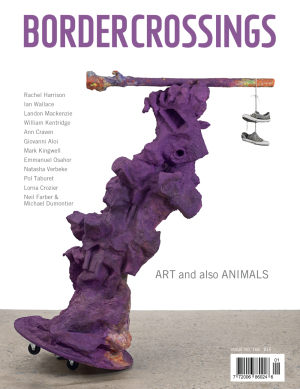Speaking with the Enemy
Carel Moiseiwitsch’s huge new triptych, Trophies, is a gamble of sorts for the Vancouver artist. Having eschewed painting for more than a decade in favour of less commodifiable forms (notably large scale drawings and multiples such as comic books and posters), Moiseiwitsch has returned to it now in what is perhaps its darkest hour. In so doing, she has had the gall to employ that most unfashionable of styles, Expressionism, risking all-out ostracization from the photo-conceptual mafia who rule the art roost in Vancouver.
Comprised of three unstretched canvas panels together measuring a whopping 45 feet, Trophies exemplifies Moiseiwitsch’s concerns (obsessions, really) with raw and brutal imagery, the degradation of nature and gender politics. Two gigantic female elephants, either partially flayed or lit up by X-rays, flank a more abstract central image which has been painted in the manner of a Rorschach test. Moiseiwitsch limits her palette to vibrant red, white and blue, which she applies chiaroscuro fashion to a black ground. Using acrylic paint and pastels, she builds up a tempest of the scribbles, daubs and drips which typify Expressionist art.
While the theatrical potency of such a monumental piece is perhaps predictable, it is nonetheless real. Moiseiwitsch’s bravura mark-making coheres into intricate and brilliantly organized compositions. The pigment, saturated almost to the point of spontaneous combustion, burns like hot coals on the wall. Moiseiwitsch shamelessly seduces the viewer with juicy painting and lurid effects. There is a desperate sensuality to the piece, which continually rewards the gaze; at the same time, the viewer is deliberately repelled by the grotesque violence of both the imagery and its means of execution. Much of which is, however, pretty standard stuff in the Expressionist realm.
Moiseiwitsch is doing something very, very well, but as she surely realizes, the real issue is that she is doing it at all. Since its last gasp of notoriety in the early 1980s, Expressionism has become what must be one of the most vilified practices in art history. Semiotics and theories related to it, which have come to monopolize the language of art criticism in the last decade, treat all forms of “cultural production” as equally conventional, mediated and codified. Expressionism, which proclaims its own freedom from convention in the authentic and original expressive gesture of the painter, is thus seen as false—a “‘gestuary’ of largely self-aware acts” as American critic Hal Foster described it.

Carel Moiseiwitsch, Trophies, 1994, acrylic on unstretched canvas with grommets, triptych, each panel 10 x 15’.
Whatever inadequacies these positions may prove to have there is little question that they have taken deep root in contemporary visual art. The promise of pluralism which accompanied the initial articulation of postmodernism has largely evaporated as theory has come to be seen as essential to an increasingly conceptual/textual/photo-based high-art mainstream. Unsurprisingly, artists have scrambled to play catch-up, immersing themselves in bad translations of dense French structuralism in the forlorn hope that they can make up for having read nothing but Beat Poetry while in art school.
Vancouver, currently Moiseiwitsch’s home, has been particularly hard hit by this mania. Its effect in the experimental art community is evidenced by the catalogue which accompanies Trophies. Curator Robin Laurence, in an introductory essay, acknowledges that Moiseiwitsch is engaging in a “critically discredited” and “academically condemned” form, and points out that the “photo-conceptual academy”
…represents another kind of establishment, another kind of orthodox-ridden vehicle for commodification and museumization. Photo-technologies, endorsed by both curatorial and academic institutions, have risen to the top of the visual art hierarchy, establishing yet another condition by which male power is privileged, military and corporate methodologies are mimicked, (and) masculine notions of technological superiority and heroic scale are perpetuated….
Moiseiwitsch, although perhaps a little guilty of this “heroic scale” thing herself, is championed for her “resistance” and “subversion” of “academically sanctioned practice.” A second essay, by Holly Owen, adds to this critical buttressing by ascribing a multitude of weighty significances to even the tiniest details of the piece. We are informed, at various points, that Trophies embodies or alludes to postmodernism, feminism, Islamic culture, premodern grotesque realism, quantum physics, heraldic imagery, ecological concerns and even “other realms.” While all this may be true, I still found it a little irritating to be so thoroughly briefed on how to read the piece. After all, the central motif, a giant Rorschach test, would seem to imply an openness to interpretation.
These elaborate discourses struck me as an indication of the anxiety which the present intellectual climate creates for artists. Moiseiwitsch, creating work which operates outside of language and the codes of mainstream art theory, is still compelled to surround her art with texts that speak that language. To merely imply that the whole of human experience is irreducible to a set of abstract signifiers takes on the character of a radical act. Are any other media in contemporary Western culture as rigidly policed as are the visual arts?
In referring to her own work, Carel Moiseiwitsch says: “I’ve learned to justify my art in a theoretical way, but I hope it has a more profound and inarticulate impulse.” Looking at Trophies, despite hundreds of texts whispering otherwise in my ear, I was forced to agree. ♦
Kevin Mutch is an artist and critic who is now living in Vancouver.
Trophies by Carel Moiseiwitsch was on exhibition at the Pitt Gallery in Vancouver from September 8 to October 8, 1994.

